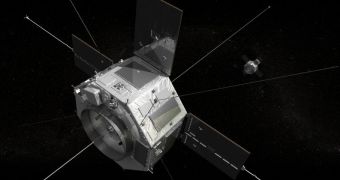In August 2012, NASA will launch a new series of scientific spacecraft, called the Radiation Belt Storm probes (RBSP). The purpose of the mission is to find out more data about the Van Allen radiation belts surrounding our planet.
While most objects on Earth are electrically neutral, this is not the case for most of the Universe. In fact, the vast majority of the Cosmos is made up of electrified gas known as plasma. Our planet is protected from these influences by a layer in its atmosphere called the magnetosphere.
Studies conducted in the late 1950s discovered two very large, donut-shaped conglomerations of plasma surrounding Earth. Located at altitudes between low-Earth (LEO) and geostationary (GEO) orbits, these structures are trapped in a region of space known as the Van Allen radiation belts.
Though discovered more than 50 years ago, they are still very mysterious to physicists, and it will be the purpose of the RBSP mission to settle some of the debate centered on these structures. NASA is very interested in what makes plasma move in and out of these areas, and why.
While the inner Van Allen belt maintains a relatively steady plasma count, the outer one can swell up by 100 times over or more in very short intervals. When this happens, its boundaries move through GEO, engulfing a large number of communications and positioning satellites.
When the phenomenon was first discovered, it made scientists very curious as to what may be causing this significant shift in size. However, it quickly became apparent that understanding the changes of the outer Van Allen belt required a deep understanding of plasma motions, which was unavailable.
“We discovered the radiation belts in observations from the very first spacecraft, Explorer 1, in 1958. Characterizing these belts filled with dangerous particles was a great success of the early space age, but those observations led to as many questions as answers,” David Sibeck explains.
“These are fascinating science questions, but also practical questions, since we need to protect satellites from the radiation in the belts,” adds the expert, who is an RBSP mission expert, and a space scientist at the NASA Goddard Space Flight Center (GSFC), in Greenbelt, Maryland.
RBSP will include two identical spacecraft, each of which will be carrying the exact same instruments.
These are the Energetic Particle, Composition, and Thermal Plasma (ECT) instrument suite, the Electric and Magnetic Field Instrument Suite and Integrated Science (EMFISIS), the Electric Field and Waves Instrument (EFW), and the Radiation Belt Storm Probes Ion Composition Experiment (RBSPICE).
The US National Reconnaissance Office (NRO) is contributing an instrument of its own, the Relativistic Particle Spectrometer (RPS), NASA reports.

 14 DAY TRIAL //
14 DAY TRIAL //